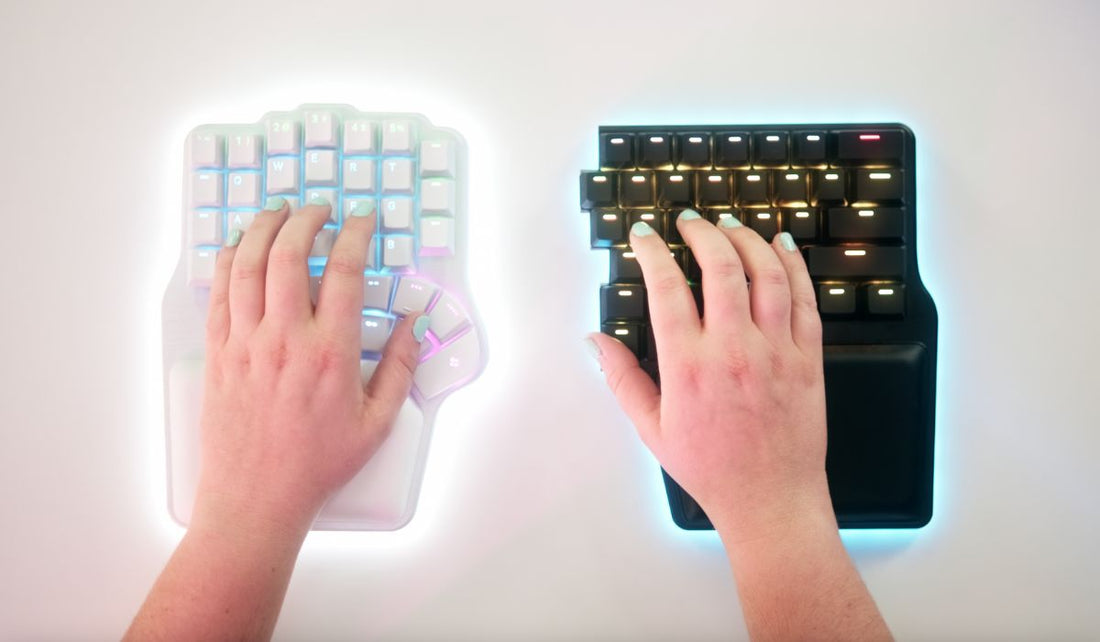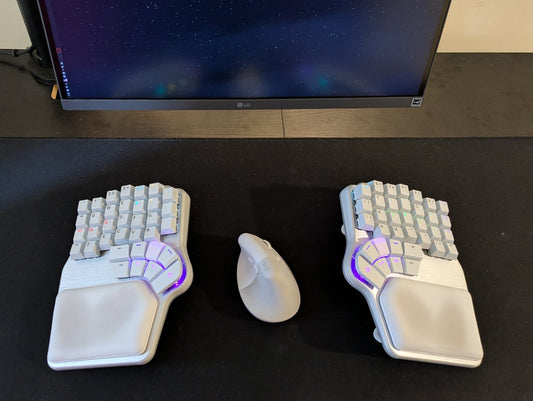When it comes to big decisions in life, like making the grand choice between buying The Dygma Raise 2 or the Defy, a little help might come in handy.
First of all, why choose a split keyboard in the first place? Leaving the safe and comfortable shores of standard, fixed keyboards to jump into the ocean of split ergonomic keyboards can seem daunting.
Much like jumping into an unfamiliar ocean filled with great whites. It may lead you to ask yourself some pretty valid questions like:
Am I getting myself in too deep with my typing expectations? Will I struggle swimming around this new sea of split keyboards, or will this end up biting me in the ass?

We can assure you that the answer to these questions is a resounding NO.
Although on the surface, it may seem like deep, scary waters, the minute you dunk your head, you'll find yourself in pristine, clear, much more comfortable, and relaxed waters.

Creating that more comfortable, relaxed environment is precisely why we built our split ergonomic keyboards in the first place. The ultimate goal is to rid everyone of their ergonomic struggles and help increase workflow, productivity, and desk-top sexiness worldwide.
Raise 2 vs. Defy: the similarities
Well, both keyboards share a lot of great features.
For example, each has a split design with integrated tenting and reverse tilting, which allows you to freely adjust the position of your hands, encouraging perfect, open-chested, upright, ergonomic posture nirvana.

Plus, both keyboards are wireless, so you explore alternative setups like placing the keyboard halves on your armrest. But you're imagination is the limit.
Consequently, 93% of our users have reported feeling far less discomfort after spending long hours at the keyboard.
If you look a little closer at both keyboards, you'll also notice that there are now multiple keys in the spot where a single space bar would typically reside.
Let's face it: on a standard keyboard, a lot of space is occupied by a single key that only performs a single function. So we decided to break it up.

Not only could we increase productivity by assigning more functions to these new keys, but we could simultaneously reduce repetitive strain on the wrist by giving YOU the power to assign outer-ring keys to those ever-handy thumb keys!
Our third major similarity is that both The Dygma Raise 2 and The Dygma Defy can be fully personalized, programmed, and configured to suit your wants and demands via our ever-updating software, Bazecor.

And it's here in Bazecor that you have the power to design and program multiple layers for your Raise 2 or Defy to suit whatever task you have at hand. Be it typing, gaming, coding or a combination of every task you can ever think of!

Finally, you can personalize your keyboard even further by adding a little flare to your keys! Each key has an RGBW LED that you can customize, and we have the under-glow making your desk look like the coolest nightclub in town.
Raise 2 vs. Defy: the differences
Well, we've covered the similarities, so the answer to that question must lie in the differences between the two.
The first difference you're going to notice is the overall key layout.

The Raise 2 maintains a more traditional, staggered layout –the one you find on conventional keyboards– while the Defy introduces a more ergonomic, columnar layout.
So why did we introduce this crazy columnar layout? Look down at your fingers right now. Do they look like this?

Probably not, right?
The columnar layout considers the varying finger lengths, promoting a more intuitive finger placement while further reducing wrist and finger strain as the fingers follow their natural movement to reach the upper and lower keys.
Second, we have a significant difference in the actual split itself.

As you can see, the two halves of the Raise 2 can be connected at any time to create a fixed, more standard-looking 60% keyboard.
The Defy, on the other hand, cannot and should not ever be connected. It's a permanently split keyboard. The two halves are teammates but not lovers. They work together... but never slot together.

Like two sexy colleagues who have a mutual understanding of the fireworks, they could potentially create together but have independently decided for the true success of the company; they must only ever remain as colleagues.
Next, let's look closely at those thumb cluster keys. The Raise 2 has 8, while The Defy has 16 in total.
Check out how and why we managed to fit so many keys yet make it super-comfortable right here:
In short, this remarkable little thumb cluster follows the natural arc motion of your thumb, so you can comfortably reach multiple keys and give your strongest and most flexible finger more things to do.
Thanks to this thumb cluster, we could remove the furthermost keys from the right side, along with the modifier row, further reducing strain from the weakest fingers on your body, your pinkies.
Lastly, only The Raise 2 has the potential to incorporate add-ons such as extra thumb keys or a trackball.

These are the most relevant differences between The Dygma Raise 2 and The Dygma Defy.
Ultimately. the answer to this question truly depends on the stage of your 'ergonomic journey.'
Which one should you buy?
The Dygma Raise 2
The Dygma Raise 2 is the perfect gateway keyboard into the world of keyboard ergonomics, so if you're only just embarking on this journey, then that's the one we recommend getting.

Right out of the box, it works like a 60% keyboard, and from there, you can start adjusting to using it split.
But, if you feel overwhelmed at any point, after a quick clickity-clack, you'll have your 60% keyboard back with no split in sight.
As you become more comfortable and confident, you can introduce an increased separation between the two halves, gradually working your way to your most ergonomic position. 
The same applies to its programmability. You can use a standard key arrangement at first, and then, over time, you can dive into the realms of Bazecor to customize your layout, start using the thumb keys, add macros, configure superkeys, and create multiple layers, too!

The more traditional spacebar-positioned thumb cluster and the conventional staggered key layout simply require far less muscle memory shifting than the Dygma Defy. So your typing won't suffer too much of an initial shock when starting this incredible journey.

Situationally, you might find yourself switching a lot between your laptop and keyboard throughout the day. In this case, keeping that staggered key layout on the Raise 2 is your best bet.

But let's say you've been working with The Dygma Raise or perhaps another split-design keyboard, such as the ErgoDox or the Kinesis Freestyle Edge, and now, you're ready to up your game.
The Dygma Defy
This is when you should seriously consider The Dygma Defy.
Of course, there will be an adjustment period, but if you've already ticked off enough boxes using split hand typing, columnar key layouts, or thumb clusters, then now is the perfect time to make the next step.

You'll certainly appreciate the extra comfort of the columnar layout and the additional thumb keys. The highest level of Dygma ergonomic Nirvana, if you will.
We hope this article has answered the ultimate question when choosing between the two, but if we've left something out, please don't hesitate to write in with any burning questions you may have.

Make sure to check out our YouTube channel! Give us a like, and if you haven't subscribed yet, please do that too.
Thank you for all your support!
G'day! 🪃
- The Dygma Team









